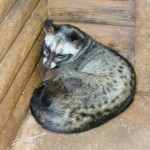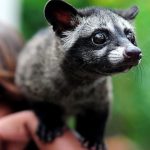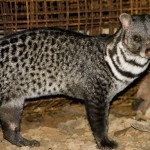These smaller civet-like animals, found throughout the forests of Asia, are easily recognizable by their dark, coarse fur and large eyes. The Asian palm civet is otherwise called the normal palm civet and the Toddy Cat is zones where the Asian palm civet is locally discovered.
The Asian palm civet is considered possessing the tropical wildernesses and rainforests all through much of Asia. The fundamental populaces of the Asian palm civet however are discovered in southern India, Sri Lanka, South-east Asia and southern China.
Lamentably, Asian palm civets have been radically influenced by expanding deforestation (and in this manner natural surroundings misfortune) in their local districts.
Behaviour :
The Asian palm civet is extensively spread and decently usually discovered all through a lot of Asia along with in spite of their feline-such as manifestation and actions; these are not cats whatsoever yet are indeed all the more nearly identified with other minor carnivores incorporating mongooses and weasels.
Distinct erstwhile civet type the end of these cats does not contain rings, yet the embodiment of these types is grouped similar to raccoon. The Asian palm civet is lone creature that just turns out under the front of night to chase and get nourishment.
The aforementioned nighttimes creatures are fundamentally ground-residence and profoundly physical as they check their extents by dragging their butt-centric organs along the ground.
In spite of being predominately ground-abode however the Asian palm civet is known to ascend into the trees either in hunt of nourishment or to cover up from approaching predators.
Diet :
The Asian palm civet is a flesh eating creature, and like different species of civet, it gets by on a meat-based eating methodology, supplemented by the odd plant or products of the soil.
Minor creatures for example rodents, reptiles, snakes and frogs make up the dominant part of the Asian palm civet's eating regimen, in addition to creepy crawlies and other minor animals abandoning through the under-development.
Asian palm civets are likewise known to consume the products of the soil of palms, mangos and java in their common territories.
Predators :
Notwithstanding being a shrouded yet comparatively fierce ruthless creature, the Asian palm civet is really gone after by various predators inside their characteristic surroundings. Hefty savage felines are the most normal predators of the Asian palm civet incorporating tigers and panthers in addition to reptiles for example hefty snakes and crocodiles.
Life Cycles & Lifestyle :
The female Asian palm civet generally conceives up to 4 youthful after a growth period that keeps up for a few months. The toddlers are weaned by their mother until they are solid enough to battle for themselves. Asian palm civets can exist for up to 20 years, in spite of the fact that most infrequently get to be this old.
Today, the Asian palm civet is under danger from deforestation and subsequently exceptional misfortune of much of its characteristic environment. The principle explanation behind such noteworthy deforestation in the zone is either for logging or to clear the area to clear a path for palm oil ranches.
The Common Palm Civets species name originates from the way that both male and female have fragrance organs underneath the tail that take after testicles. It can spread a destructive discharge from the aforementioned organs. The normal palm civet is lone, night times and arboreal.
Also read:
Normal Palm Civets use the day slumbering in a tree empty. Regular Palm Civets are territorial. Common Palm Civets recreate all through the year in spite of the fact it has been recorded that cats are most frequently viewed from October to December.
Cats are born in a litter of 2 to 5 junior. Palm civets come to be sexually developed at 11 to 12 months. In bondage the normal palm civet can satisfy 22 years. Young are born in tree hollows or in stone fissure. Throughout short times of chum and after the females contain their youthful; the civets engage latent plants jointly.
Habitat :
Asian Palm Civet the 'Toddy Cat ‘or "Musang", is a feline-estimated warm blooded creature that lives in the Southeast Asian tropical rainforests. The Common Palm Civet is discovered from the southern China and Himalayas, the Malay Peninsula, to the Philippines, and the Indonesian islands. The Asian Palm Civet is a greatly versatile creature and can exist in thick woods, agrarian regions and even close by people.
Appearance :
The Asian Palm Civet is a nighttime’s omnivore. Its essential nourishment source is foods grown from the ground for example chiku (from a since a long time ago existed, evergreen tree local to the New World tropics), mango (a tropical apples as well as oranges of the mango tree) along with rambutan (a medium-estimated tropical tree). It additionally has an affection for palm bloom sap which, when aged, ends up being 'toddy', a sweet liquor.
The Asian Palm Civet is likewise enamoured with cafe cherries. They consume the external leafy foods coffee seeds pass through their digestive tract. An unreasonable cafe called 'kopi luwak' is supposedly produced from the aforementioned beans. Kopi luwak is stated to have an unpleasant flavour as well as advertises for more than $100 for every pound. Asian Palm Civets will consume reptiles, eggs and creepy crawlies moreover.
Images, Pics, Photos and Pictures of Asian Palm Civet :
In Sri Lanka, the Asian palm civet is regarded as "Uguduwa" by the Sinhala talking group. In above all parts of the island, the civets get a hazard to the individuals because of truth of the matter that it litters in roofs and lofts of normal family units and afterward makes noisy clamours around evening time exasperating the doze of the occupants of the house (commotions are chiefly because of their developments and battles).
Asian Palm Civets are classed as 'Least Concern'. It is abundant in its characteristic extent and is not jeopardized.














